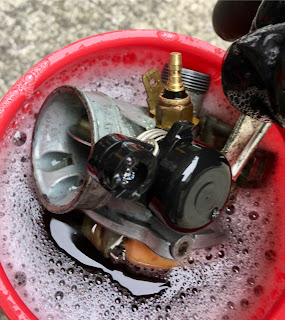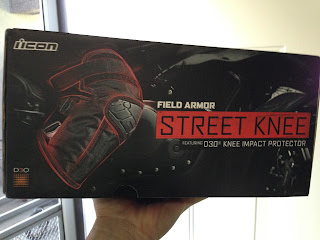Purring like a....Cub?!
It has been a little over three weeks since I brought my Super Cub home. In that time I have been as busy as I could be with our bad weather trying to get it ready for the road after it’s indefinite period on inattention. While I was able to get the bike running at the junkyard, it was showing signs of needing a little love in the carburetor area. If it was cold, it would start right up. It might have required some choke, but it would start almost always with a single kick. After it warmed up, it was a bit more recalcitrant. I decided that a quick carb rebuild was in order. Have a read and see how it went.
Now that the bike is running with no noise or leaks it is time to move onto a few chassis related items to make it road worthy. In order to get it plated I have to go through my base's Vehicle Registration Office to get the right paperwork to take to the city office for taxes and a license plate. Before that, I have to get insurance and a base safety inspection. It shouldn't take much time, but with the weather being all over the map and my pesky work schedule, it will probably take more time than I'd like. I'll keep you updated as I go. See you in the next installment of My Cub Adventures. If you can, ride safe friends!
Mat
The weather finally broke for a very short period. Japan is in its rainy season called 梅雨 (tsuyu). It is a month long period between spring and summer. When it breaks, the temps and humidity soar. Before it ends, everyday is an unpredictable gamble of "will it rain?" or "how bad will it rain?" About 30 minutes after this photo was taken, I had to throw everything into my tool box and dash inside to avoid a soaking. Over the course of the last couple of weeks, this has been how I've had to work. I got one weekend that was mostly sunny. It was a pretty hot reminder of what summer has in store for me and my bike work...
This 49cc powerhouse requires a carburetor of equal stature. I believe the carb is a PB carb with a 16mm diameter inlet. There are only a couple of bolts to remove and I was able to pop it off in less than 10 minutes. The Cub's gas tank is under the seat and the fuel hoses from the tank extend through the body along the chassis to the carb body at the front end of the bike. The petcock is part of the float bowl. I couldn't pull the bowl for service without getting a couple of line clamps to pinch off the tank. When I got it at the junkyard, it had a full tank of gas. It is only a little over a gallon, but I don't have a gas can. All of the gaskets seemed to be in good condition, but the rebuild kit was only $13 so I will replace them for good measure.
The carb didn't have much crud in it. I made up a batch of simple green and hot water to soak it in. The whole carb, minus the float bowl, fit into a small coffee can. I went on to do a few other things while the carb relaxed in its bath. When I pulled it out it was looking pretty good. I used the last of a can of canned air to blow through a few of the passages and let it sit in the sun to dry after a rinse. Simple Green is my cleaner of choice. I missed having my little Harbor Freight ultrasonic cleaner around to really get deep into inner workings of the carb and ensure a problem free future, but my coffee can soak seemed to do pretty well.
I dug around the internet and found a drawing of the PB carb from a Japanese blog. With that, and my wife's generosity in letting me use her jewelry vibrating cleaner, I set about to clean the jets and other small parts of the carb. The main jet was clear, but like I suspected the pilot jet was partially plugged with gunk. The idle screw and air screw were both fine and the various springs and washers came out sparkling. I know that there are better ways of getting this work done, but for the home mechanic working on an itty, bitty carb on his kitchen table while it rains, you can't really beat it. Following the drawing, I matched my unlabeled gaskets and O-rings to the carb body. I finished up the reassembly after dinner and had it ready for the next days work.
One of the coolest things about these little Cubs is the supreme ease of working on them, I thought that my CRF450 race bike was easy, but the Cub has it beat. One thing I have seen on YouTube is a lot of people installing big bore kits into Cubs and the other lay down engine variants that Honda has. In as little as a couple of hours I could have a 70cc, 85cc, 90cc or even a 110cc bike. Cam swaps are also a relative breeze as all of the work can be done without dropping the engine. I installed the Cub's carb and set about to tune the idle and mixture. I had already replaced the air filter and plug and a few engine hoses. I also checked the valve clearance so I was pretty sure I had a nice base to start my tuning. When I went to start it up, it started on the first kick and settled into a high idle. A twist of the idle screw and it would run smooth and even. I did have to work on a run away issue that had me perplexed for a couple of days. I changed a pinched gasket and reinstalled the slide needle spring that holds the needle in the slide. I didn't have it seated all the way and I believe that when I gave it some gas, the slide would lift up an extra bit causing the engine to take off. It still hangs slightly, but I think that I'll make some adjustments with the mixture screw after I ride it for a bit.Now that the bike is running with no noise or leaks it is time to move onto a few chassis related items to make it road worthy. In order to get it plated I have to go through my base's Vehicle Registration Office to get the right paperwork to take to the city office for taxes and a license plate. Before that, I have to get insurance and a base safety inspection. It shouldn't take much time, but with the weather being all over the map and my pesky work schedule, it will probably take more time than I'd like. I'll keep you updated as I go. See you in the next installment of My Cub Adventures. If you can, ride safe friends!
Mat









Comments
Post a Comment
Thanks for your comments and for following My Motorbike Obsessions!